Clipart tagged: ‘raptors’

Birds of Prey
"Birds of Prey" are birds who hunt for their food (other animals or meat) in flight. When they find…
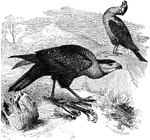
Caracaras
"Polyborus auduboni. Common Caracara. General color blackish, the throat, neck all around, and more…
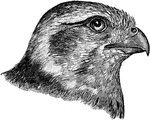
Prairie Falcon Head
"Falco mexicanus. American Lanner Falcon. Prairie Flacon. A medium-sized species, distinguished from…

Falcons
"Falcons. Bill furnished with a sharp tooth and notch near the end of the cutting edge of the upper…
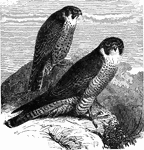
Two Lanner Falcon
"Falco mexicanus. American Lanner Falcon. Prairie Flacon. A medium-sized species, distinguished from…
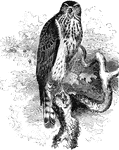
American Goshawk
"Astur atricapillus. American Goshawk. Blue Hen Hawk (adult). Chicken Hawk (young). Adult: Above, dark…
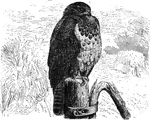
European Hawk
"Buteo vulgaris. hawk of Europe, Upper parts dark brown, very variable in shade according to season…

Marsh Hawk
Birds of prey usually have stout, hooked beaks and sharp, curved claws, fitting them for clutching and…
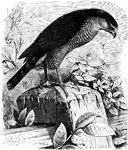
Sharp-shinned Hawk
"Accipiter fuscus. Sharp-shinned Hawk. "Pigeon" Hawk. Above, dark plumbeous, slate-color, or bluish-gray,…
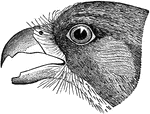
Sparrow Hawk
"Falco sparverius. Rusty-crowned Falcon. Sparrow Hawk. Adults: Crown ashy-blue, with a chestnut patch,…
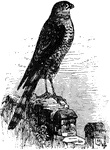
Sharp-shinned Hawk - Small
"Accipiter fuscus. Sharp-shinned Hawk. "Pigeon" Hawk. Above, dark plumbeous, slate-color, or bluish-gray,…
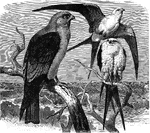
Two Swallow-tail and One Mississippi Kites
Two Swallow-tail and One Mississippi Kite. "Ictinia subcaerulea. Mississippi Kite. General plumage plumbeous…

Burrowing Owl
"Speotyto cunicularia hypogae'a. Burrowing Owl. Adult: Above, dull grayish-brown, profusely spotted…
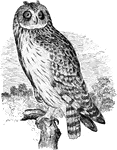
Short-eared Owl
"Asio accipitrinus. Short-eared Owl. Marsh Owl. Ear-tufts inconspicuous, much shorter than middle toe…
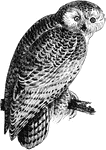
Snowy Owl
"Nyctea scandiaca. Snowy Owl. Pure white, spotted and barred with brownish-black markings, wholly indeterminate…
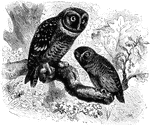
Saw-whet and Sparrow Owls
"Nyctala - Saw-whet Owls. Skull and ear-parts highly unsymmetrical, the the latter of great size, and…
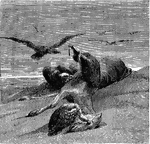
Vultures
A group of vultures, three on the ground, eat their prey. Several vultures are approaching those already…